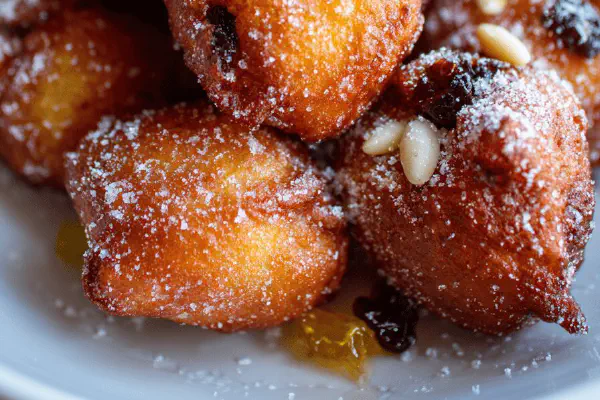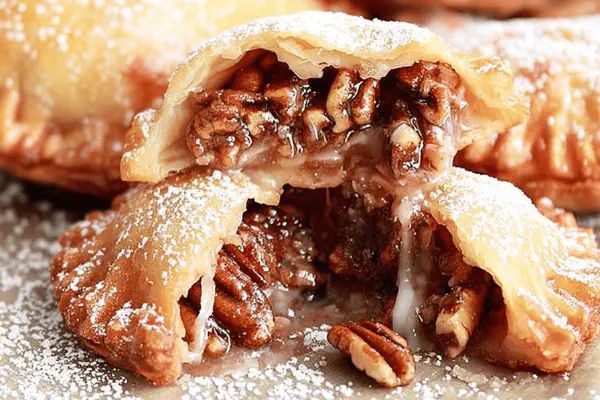Carnival Fritters Twist

By Emma
Certified Culinary Professional
Ingredients
- 130 ml handpicked raisins soaked overnight in 50 ml dry white wine
- 250 ml warm milk (about 38°C)
- 15 ml instant yeast (3 tsp)
- 2 large eggs
- 40 ml caster sugar (tablespoon slightly heaped)
- 1 pinch fine sea salt
- 40 ml melted unsalted butter, cooled
- 700 ml all-purpose flour sifted
- 150 ml mixed candied citrus peel, diced small
- 120 ml toasted pine nuts
- Zest of 1 lemon
- 15 ml orange blossom water (for twist)
- Vegetable oil for deep-fat frying
- 150 ml granulated sugar for coating
About the ingredients
Method
The night before
- Soak raisins in wine. Cover bowl, let plump and infuse overnight. Dry wine preferred to avoid extra sweetness. If stuck, substitute dry sherry or brandy. Avoid soaking in rum; it mutates flavor balance here.
On fry day
- Warm milk to luke-warm warmth; test on wrist. Mix yeast until dissolved, no lumps—listen for faint scent of fermentation starting.
- Add eggs, sugar, salt, melted butter. Stir well. Sugar feeds yeast but too much will kill bubbles. Balance critical.
- Fold in flour gradually. Use a wooden spoon to bind ingredients into soft dough. Avoid stiff paste; think relaxed batter that’s tactile not sticky.
- Add soaked raisins with liquid, candied peel, pine nuts, lemon zest and splash orange blossom water for floral note; subtle but noticeable.
- Now comes labor: lift dough from underneath and fold over top, rotating bowl – roughly 25 minutes by hand creates aeration, look for shimmering bubbles breaking through surface. No mixer? Patience pays off. Or if machine’s ready, mix low speed 12 minutes, don’t shortcut.
- Cover with damp towel, keep near warm spot but not hot. Dough should double, visible puff with finger poke wobbles back slowly—indicates yeast activation and gluten development.
- Preheat oil to 175°C (350°F) — use neutral vegetable oil to avoid flavor interference and smoke point issues.
- For shaping: two spoons scoop about 30 ml dough into hot oil. Do not overcrowd; fry in batches for temperature stability.
- Each fritter fries for 2-3 minutes per side. Listen for steady crackle, golden brown edges indicate crisp, not burnt. Drain on paper towels suds off excess; immediately toss in sugar to coat before cooling stiffens shells.
- Serve warm, sugar crackling audible on bite, fragrance of citrus bright but delicate with soft raisins punctuating.
- If dough collapses or is dense after fry, next batch knead more or extend warm rise by 10 minutes. Ambient temperature impacts time.
- Store leftovers in airtight container but best day of fry; refresh in low oven if needed.
Cooking tips
Chef's notes
- 💡 Raisins need soaking long to plump, wine must be dry or bitterness creeps. Substitute dry sherry if stuck, but avoid rum soaking or flavor turns off balance. Raisins bring moisture; keep that in check to not slacken dough
- 💡 Kneading not about speed but folding rhythm, twenty-five minutes hand-work triggers bubble rise, feel dough stretch, watch surface shimmer. If no mixer, patience wins. Mixing low power twelve minutes with machine works. Avoid shortcut or get dense lumps
- 💡 Butter must be melted cool, never hot or yeast dies silently. Salt is pinch only, balance yeast sugar feeding; too much sugar kills bubbles, too little yeast gets no rise. Warm milk wrist-test 38°C or bubbles slow, cold slows yeast too
- 💡 Oil temperature precise 175°C stable fry point. Use neutral veg oil to skip smell clash and smoke. Overcrowding pan kills temperature, fritters stick or soggy crust. Fry two spoons-sized dough batches, hear crackle, flip golden edges fast
- 💡 Sugar coating immediately while hot; delays mean sugar slides off, no crackle. Powdered sugar clumps; granulated works best. Leftovers revive in warm oven to restore crunch without oily mess. Dough toughness reversible with extra knead or warm spot for rise
Common questions
Why soak raisins in wine not rum?
Rum's sweetness overpowers citrus and dough balance. Wine less sweet, keeps raisins plump but avoids sticky sogginess. Dry sherry works if wine missing. Tested rum, flavor flop.
Dough too dense after fry?
Knead more if it collapses, fold slowly to build bubbles. Warm rise helps yeast work, watch not clock. Cold kitchen slows yeast, reheating dough warmer spot fixes slow. Too much flour kills softness.
How to know oil is ready?
175°C stable heat key. Flick small batter test, crackle sound. No thermometer? Use bread cube test, color quick gold brown. Overheat burns edges raw inside; fish oil smell means too hot, cool down.
Storing fritters?
Airtight container best same day. Fridge makes shell chewy, revive in warm oven for crunch. Freezing possible but impacts texture; thaw carefully. Leftovers lose sugar crackle fast; coat fresh if needed.



